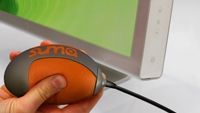Suma technology lets users feel their way around 3-D environments

Cambridge Consultants, a technology product design and development firm, has unveiled the second development of its Suma-enabled technology. The flexible platform technology offers enhanced functionality for PC peripherals.
With full analog control from all fingers and thumb, the latest Suma technology has been developed into an ergonomic “Suma mouse” concept, showcasing its versatility and ability to unlock the human sense of touch when interacting with next-generation applications.
Unlike a traditional mouse, the new Suma mouse concept makes the click, pan, zoom and tilt maneuvers required when browsing a 3-D environment a much more intuitive and natural experience. Squeezing, stroking, rotating and pressing the Suma skin will all give an individual reaction on the screen.
With everyday applications such as Google Maps now rendering in three dimensions, there is a growing demand for the right interface to exploit their potential. When using a Suma-enabled mouse, there are no set boundaries for how to hold it or where to place your fingers. A Suma skin-enabled mouse can recognize how the user is holding it and wherever they have placed their fingers, making it a comfortable and natural process.
While consumers are now familiar with gesture-based controls and motion feedback, these do not fully exploit the subtlety and flexibility of our hands and control capabilities to the degree Suma technology can. With this increased versatility, and without the requirement for distinct and separate buttons, the next generation of 3-D computer and gaming devices can be much more ergonomic in their design.
The new Suma platform can be implemented in any shape, from mouse to joystick, integrating an analog deformation sensor within the device. The sensor network can be tuned to each application, including resolution, sensitivity and stiffness of the deformable layer and active area. The Suma skin can be integrated at an incremental parts cost of less than $1, allowing it to be designed into conventional controllers, as opposed to specialist equipment.
The professional video industry's #1 source for news, trends and product and tech information. Sign up below.
